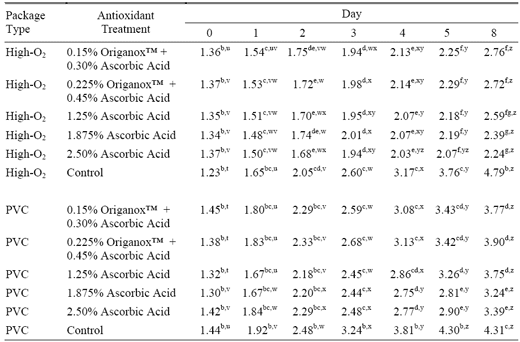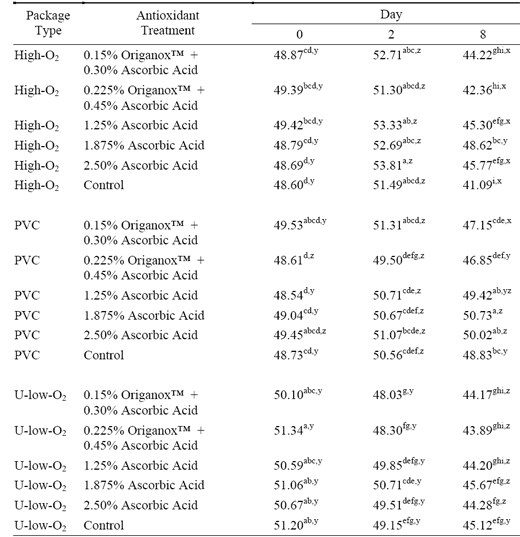Evaluation of Topical Antioxidants and Packaging Materials to Decrease the Incidence of Bone Discolo
Color characteristics were evaluated on 48 pork backbones. After 6 d postmortem, six 1- inch-thick sections of lumbar vertebrae were cut from each backbone. Lumbar vertebrae were treated with different concentrations of ascorbic acid, with combination treatments of ascorbic acid and natural antioxidants, or left untreated.
Bones were packaged in one of three systems: high-oxygen modified-atmosphere packaging (MAP), ultra-low-oxygen MAP, or polyvinyl chloride (PVC) overwrap trays. Bones were visually evaluated by a trained panel on d 0, 1, 2, 3, 4, 5, and 8. Lightness (L*) was also measured on d 0, 2, and 8 of display. After 8 d of display, antioxidant- treated bones packaged in highoxygen MAP were more desirable than those in PVC overwrap trays. Bones packaged in ultra-low-oxygen MAP became less desirable over 8 d of display.
Solutions of 1.875% and 2.50% ascorbic acid yielded the most desirable color after 8 d for bones in high-oxygen MAP and in PVC overwrap trays. Bones treated with 1.875% or 2.50% ascorbic acid tended to have lighter color (higher L*) on d 8 for high-oxygen MAP and PVC overwrap trays, whereas an overall difference was not observed for lightness for bones packaged in ultra-low-oxygen MAP.
Introduction
Bone color in fresh retail cuts is important to consumers. High-oxygen MAP and PVC overwrap trays are packaging methods conducive to red color development, but bone discoloration or darkening can be a problem in these systems. It has been shown that feeding antioxidants to livestock, and the application of antioxidants in processing, both can inhibit bone darkening. Recent research at Kansas State University has shown that the application of 2.50% ascorbic acid minimizes beef bone discoloration within these packaging systems. The objective of this study was to evaluate the effects of topical antioxidants on the development of bone discoloration and/or darkening in pork lumbar vertebrae packaged by using three different packaging systems.
Procedures
Forty-eight pork backbones from 1 day's kill were obtained from a commercial abattoir, from which six 1-inch-thick sections of lumbar vertebrae were cut at 6 d postmortem by using a band saw and were brushed to remove bone dust. One cut section from each backbone was treated with a 0.5-mL aliquot of one of five treatments: 1.25%, 1.875%, or 2.5% ascorbic acid solution (L-ascorbic acid, Sigma-Aldrich, St. Louis, MO); a combination treatment of 0.15% Origanox® WS (Rad Natural Technologies Ltd., Tikva, Israel) and 0.30% ascorbic acid solution; or 0.225% Origanox® WS and 0.45% ascorbic acid. The sixth section was used as the control, with no treatment applied. Bones were packaged such that the six vertebral pieces represented all six treatments and came from the same backbone. Three packaging systems were used: high-oxygen (80% O2, 20% CO2) MAP; ultralow- oxygen (70% N2, 30% CO2) MAP containing an activated oxygen scavenger; and polyvinyl chloride (PVC) overwrap. Highoxygen and ultra-low-oxygen packages were packaged in rigid trays and covered with barrier lidding film. The PVC samples were packaged in foam trays with oxygen permeable film.
Packages were displayed under continuous fluorescent lighting (2153 lux, 300K and CRI=85, Bulb Model F32T8/ADV830/Alto, Phillips, Bloomfield, NJ) for 8 d at 2ºC in a retail display case. Packages were rotated twice daily to maintain random display-case placement.
Six trained visual panelists scored bone marrow color once a day on six days beginning on d 0 (d 0 to d 5), and also once on d 8 of the display period. A seven-point scale was used for high-oxygen MAP and PVC packages: 1) bright reddish-pink to red, 2) dull reddish-pink, 3) slightly grayish-pink or -red, 4) grayish-pink or -red, 5) moderately gray, 6) all gray or grayish-black, and 7) black discoloration. Ultra-low-oxygen MAP samples were scored according to a different sevenpoint scale, and ultra-low-oxygen meat tends to have a more "purplish" color than red color: 1) bright purplish-red or -pink, 2) dull purplish- red or -pink, 3) slightly grayish-purple or -pink, 4) grayish-purple or -red, 5) moderately gray, 6) all gray or grayish-black, and 7) black discoloration. Both scales were used in halfpoint increments, and panelists were instructed to score the porous portion of the bone marrow.
Instrumental CIE L* measurements were taken twice on each cut vertebral section by using a 0.25-inch aperture (Illuminant A) with a Hunter Labscan 2 (Hunter Associates Laboratory, Inc., Reston, VA), and then averaged. Instrumental measurements were taken from all samples on d 0, from 24 opened packages on d 2, and from 24 opened packages on d 8. Those measured on d 2 were reserved strictly for that purpose, and those on d 8 were also those scored by the visual panel. L* corresponds to lightness, where a higher L* value equates to lighter color.
The data were analyzed with SAS PROC MIXED (SAS Institute, Inc., Cary, NC). Pairwise comparisons of least squares means were used to determine significant differences (P<0.05).
Results and Discussion
There was an interaction for visual color between packaging type, day, and antioxidant treatment for lumbar vertebrae packaged in PVC overwrap and in high-oxygen MAP. Because the same color scale was used, those packaging systems can be compared. Ultralow- oxygen MAP used a different color scale than PVC and high-oxygen MAP did, thus barring comparison. For Ultra-low-oxygen, there was only a day effect.
Control lumbar vertebrae packaged in PVC and high-oxygen MAP did not exhibit (P<0.05) graying until d 3 and d 4 of display, respectively (Table 1). From d 2 to d 8, antioxidant- treated lumbar vertebrae packaged in high-oxygen MAP had better visual scores (P<0.05). By d 5 of display, lumbar vertebrae packaged in PVC and treated with either of the Origanox®-ascorbic acid treatments or 1.25% ascorbic acid exhibited (P<0.05) graying, whereas like-treated bones packaged in high-oxygen MAP did not. By d 5, the least desirable (P<0.05) lumbar vertebrae was the PVC-packaged control. Antioxidant-treated bones packaged in high-oxygen MAP had the most desirable (P<0.05) visual color on d 5. On d 8 of display in high-oxygen MAP, samples treated with higher concentrations of ascorbic acid alone had visual color scores superior (P<0.05) to those of samples treated with the Origanox®-ascorbic acid; the color scores of samples treated with 1.25% ascorbic acid were intermediate (P<0.05) (Table 1). All antioxidant-treated lumbar vertebrae in high-oxygen MAP had superior (P<0.05) color scores to those in PVC trays. Control lumbar vertebrae packaged in high-oxygen MAP exhibited the least-desirable (P<0.05) visual color on d 8. For PVC-packaged bones, treatments with 1.875% or 2.50% ascorbic acid yielded better (P<0.05) visual color values on d 8 than did other treatments.
Table 1. Visual Color Scoresa of Pork Lumbar Vertebrae Displayed for 8 Days in High-Oxygen MAP or PVC Overwrap Packaging

a 1=bright reddish-pink to red, 2=dull reddish-pink, 3=slightly grayish-pink or -red, 4=grayish-pink or -red, 5=moderately gray, 6=all gray or grayish-black, and 7=black discoloration.
b,c,d,e ,f, g Means having different superscript letters within columns differ (P<0.05).
t,u,v,w,x,y,z Means having different superscript letters within rows differ (P<0.05).
High-O2 = High-oxygen modified atmosphere packaging (MAP).
PVC = Polyvinyl chloride overwrap trays.
Visual color scores of lumbar vertebrae packaged in ultra-low-oxygen MAP declined (P<0.05) from d 0 to d 3, and stabilized from d 3 to d 5 of display (Table 2). The least-desirable (P<0.05) visual color score was on d 8.
Table 2. Visual Color Scoresa of Pork Lumbar Vertebrae Displayed for 8 Days in Ultra- Low-Oxygen MAP Packaging, Pooled Across Treatments

a 1=bright purplish-red -pink, 2=dull purplish or -pink, 3=slightly grayish-purple or -pink, 4=grayish -purple or -red, 5=moderately gray, 6=all gray or grayish-black, and 7=black discoloration.
b,c,d,e,f Means having different superscript letters differ (P<0.05).
L* values correspond to lightness, and higher L* values indicate lighter-color samples. For all lumbar vertebrae packaged in high-oxygen MAP, L* values increased (P<0.05) from d 0 to d 2 and decreased (P<0.05) from d 2 to d 8. MAP (Table 3).
Table 3. L* Values of Pork Lumbar Vertebrae Treated with Different Antioxidants and Displayed for 8 Days

a,b,c,d,e,f Means having different superscripts within columns differ (P<0.05).
x,y,z Means having different superscripts within rows differ (P<0.05).
High-O2 = High-oxygen modified atmosphere packaging (MAP).
PVC = Polyvinyl chloride overwrap trays.
U-Low-O2 = Ultra-low oxygen MAP.
For PVC-packaged bones, L* values were more similar across treatments. For bones packaged in ultra-low-oxygen MAP and treated with antioxidant, d 0 and d 2 L* values did not differ (P>0.05), and were lower (P<0.05) on d 8. Control lumbar vertebrae packaged in highoxygen MAP had the lowest (P<0.05) d 8 L* value (the least bright color), and PVC-packaged lumbar vertebrae treated with 1.875% ascorbic acid had the highest (P<0.05) d 8 L* value (Table 3). Among lumbar vertebrae packaged in high-oxygen MAP, the 1.875% ascorbic acid had the highest (P<0.05) L* value, thus the lightest color. Nominal differences in d 8 L* values were observed among bones packaged in ultra-low-oxygen MAP.
Bones packaged in high-oxygen MAP and treated with higher concentrations of ascorbic acid generally had more desirable visual and instrumental results. Also, it can be seen that bones packaged in high oxygen do need an antioxidant applied. The impact of an antioxidant in ultra-low-oxygen MAP was not observed, however, suggesting that they may not be needed in ultra-low-oxygen systems.
by C. R. Raines and M .E. Dikeman - Kansas State University Research and Extension
This article hasn't been commented yet.


Write a comment
* = required field